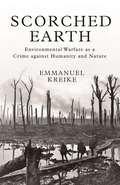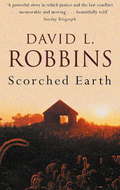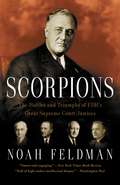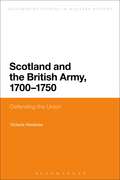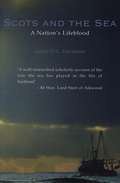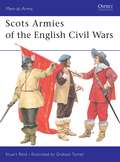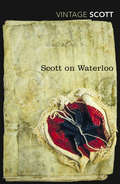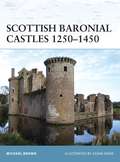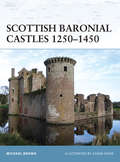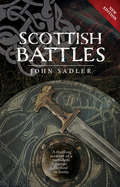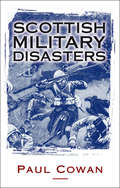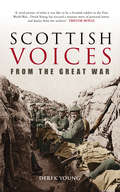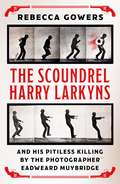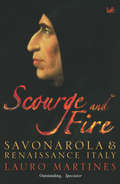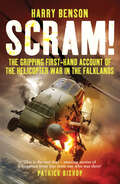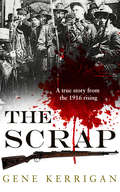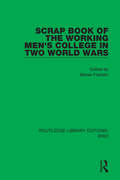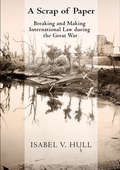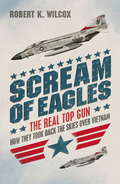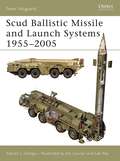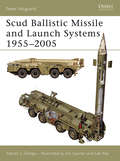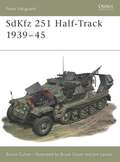- Table View
- List View
Scorched Earth: Environmental Warfare as a Crime against Humanity and Nature (Human Rights and Crimes against Humanity #38)
by Emmanuel KreikeA global history of environmental warfare and the case for why it should be a crimeThe environmental infrastructure that sustains human societies has been a target and instrument of war for centuries, resulting in famine and disease, displaced populations, and the devastation of people’s livelihoods and ways of life. Scorched Earth traces the history of scorched earth, military inundations, and armies living off the land from the sixteenth to the twentieth century, arguing that the resulting deliberate destruction of the environment—"environcide"—constitutes total war and is a crime against humanity and nature.In this sweeping global history, Emmanuel Kreike shows how religious war in Europe transformed Holland into a desolate swamp where hunger and the black death ruled. He describes how Spanish conquistadores exploited the irrigation works and expansive agricultural terraces of the Aztecs and Incas, triggering a humanitarian crisis of catastrophic proportions. Kreike demonstrates how environmental warfare has continued unabated into the modern era. His panoramic narrative takes readers from the Thirty Years' War to the wars of France's Sun King, and from the Dutch colonial wars in North America and Indonesia to the early twentieth century colonial conquest of southwestern Africa.Shedding light on the premodern origins and the lasting consequences of total war, Scorched Earth explains why ecocide and genocide are not separate phenomena, and why international law must recognize environmental warfare as a violation of human rights.
Scorched Earth
by David L. RobbinsFrom the bestselling author of WAR OF THE RATS comes a novel of searing intensity and uncompromising vision . . .The inhabitants of Good Hope, Virginia, haven't felt the cooling effects of rain in weeks. With the town a tinderbox waiting to explode, all it will take is a spark to ignite the rage and hatred so carefully hidden. And then a tragedy occurs. A baby is born and dies in her mother's arms. The child, Nora Carol, is buried quickly and quietly the next day in the churchyard. It should have ended there, but it didn't, for Nora Carol is of mixed race. The white deacons of Good Hope's Victory Baptist Church, trying to protect the centuries-old traditions of their cemetery, have the body exhumed. That night the church is set ablaze, and the sole witness is the only suspect - Elijah, Nora Carol's father. What follows is a legal case that reveals a host of hidden prejudices, incendiary secrets, and ultimately, an act of justice that has nothing to do with the law . . .
Scorpions: The Battles and Triumphs of FDR's Great Supreme Court Justices
by Noah FeldmanA tiny, ebullient Jew who started as America's leading liberal and ended as its most famous judicial conservative. A Klansman who became an absolutist advocate of free speech and civil rights. A backcountry lawyer who started off trying cases about cows and went on to conduct the most important international trial ever. A self-invented, tall-tale Westerner who narrowly missed the presidency but expanded individual freedom beyond what anyone before had dreamed. Four more different men could hardly be imagined. Yet they had certain things in common. Each was a self-made man who came from humble beginnings on the edge of poverty. Each had driving ambition and a will to succeed. Each was, in his own way, a genius. They began as close allies and friends of FDR, but the quest to shape a new Constitution led them to competition and sometimes outright warfare. SCORPIONS tells the story of these four great justices: their relationship with Roosevelt, with each other, and with the turbulent world of the Great Depression, World War II, and the Cold War. It also serves as a history of the modern Constitution itself.
Scotland and the British Army, 1700-1750: Defending the Union (Bloomsbury Studies in Military History)
by Victoria HenshawThe wholesale assimilation of Scots into the British Army is largely associated with the recruitment of Highlanders during and after the Seven Years War. This important new study demonstrates that the assimilation of Lowland and Highland Scots into the British Army was a salient feature of its history in the first half of the 18th century and was already well advanced by the outbreak of the Seven Years War. Scotland and the British Army, 1700-1750 analyses the wider policing functions of the British Army, the role of Scotland's militia and the development of Scotland's military roads and institutions to provide a fuller understanding of the purpose and complexity of Scotland's military organisation and presence in Scotland in the turbulent decades between the Glorious Revolution and the defeat of Bonnie Prince Charlie, which has been too often simplified as an army of occupation for the suppression of Jacobitism. Instead, Victoria Henshaw reveals the complexities and difficulties experienced by Scottish soldiers of all ranks in the British Army as nationality, loyalty and prejudice clouded Scottish desires to use military service to defend the Glorious Revolution and the Union of 1707.
Scotland and the British Army, 1700-1750: Defending the Union (Bloomsbury Studies in Military History)
by Victoria HenshawThe wholesale assimilation of Scots into the British Army is largely associated with the recruitment of Highlanders during and after the Seven Years War. This important new study demonstrates that the assimilation of Lowland and Highland Scots into the British Army was a salient feature of its history in the first half of the 18th century and was already well advanced by the outbreak of the Seven Years War. Scotland and the British Army, 1700-1750 analyses the wider policing functions of the British Army, the role of Scotland's militia and the development of Scotland's military roads and institutions to provide a fuller understanding of the purpose and complexity of Scotland's military organisation and presence in Scotland in the turbulent decades between the Glorious Revolution and the defeat of Bonnie Prince Charlie, which has been too often simplified as an army of occupation for the suppression of Jacobitism. Instead, Victoria Henshaw reveals the complexities and difficulties experienced by Scottish soldiers of all ranks in the British Army as nationality, loyalty and prejudice clouded Scottish desires to use military service to defend the Glorious Revolution and the Union of 1707.
Scots And The Sea: A Nation's Lifeblood
by James DavidsonWith over six thousand miles of rugged coastline, nowhere in Scotland is more than forty-five miles from tidal waters, and seven of the biggest towns and cities are seaports. No wonder then that the sea has shaped Scotland, and in turn the Scots have helped to shape maritime history, trade and communications.Scots and the Sea is a unique and compelling account of a small, sparsely populated country's relationship with the most powerful force on earth. It is a celebration of the courage and endurance of fishermen and their families, the selfless bravery of lifeboat volunteers and the individual brilliance of leaders like Admiral Cochrane, who helped establish free nations across the globe. The illicit activities of scoundrels like Captain Kidd also provide a taste of the darker side of the story. Scotland's proud maritime tradition is traced through this volume, which examines the development of trade, the founding of a Scottish merchant navy and the pressures towards Union with England. It explores ports, harbours and shipyards, and outlines the vital role Scotland has played in shipbuilding and marine engineering - from the galleys and longships of early history to clippers, steamships, ocean liners, hovercraft and oil rigs. Also recounted are the exploits and achievements of Scots in all these fields, including those of James Watt, William Symington, Henry Bell and Robert Stevenson. Finally, it takes a look into the future, where Scottish research into wave and tidal power could become vital in providing a source of sustainable energy. Over the years, many Scots have made their living and their fortune from the sea, others have lost their lives to it – Scots and the Sea is a tribute to all of them.
Scots Armies of the English Civil Wars (Men-at-Arms)
by Stuart Reid Graham TurnerIn the summer of 1642 the First Civil War between king and parliament had broken out in England. Initially both sides were confident of victory, but after the first campaigns ended in stalemate they began looking for allies. The meddling of the Stuart Kings with Scotland's religious traditions provoked the National Covenant, and later the Solemn League and Covenant. Yet many Scots continued to support the King, and after his execution, his exiled son.This fine text by Stuart Reid examines the Scots armies who fought in the English Civil Wars, and features numerous illustrations and photographs, including full page colour plates by Graham Turner.
Scots Armies of the English Civil Wars (Men-at-Arms #331)
by Stuart Reid Graham TurnerIn the summer of 1642 the First Civil War between king and parliament had broken out in England. Initially both sides were confident of victory, but after the first campaigns ended in stalemate they began looking for allies. The meddling of the Stuart Kings with Scotland's religious traditions provoked the National Covenant, and later the Solemn League and Covenant. Yet many Scots continued to support the King, and after his execution, his exiled son.This fine text by Stuart Reid examines the Scots armies who fought in the English Civil Wars, and features numerous illustrations and photographs, including full page colour plates by Graham Turner.
Scott on Waterloo (Virago Modern Classics)
by Sir Walter Scott Paul O'KeeffeOn the 200th anniversary of the Battle of Waterloo discover a fascinating primary source: Walter Scott's accounts of his journey to the battlefieldIn the immediate aftermath of the Battle of Waterloo tourists flocked from Britain to witness the scene of the most important conflict of their generation. Walter Scott was among them, and with a commission from his publisher for a travel book and a long poem. These prose and verse accounts bring to vivid life the carnage, spectacle and excitement of a fascinating period of European history. Brilliantly introduced and annotated by Paul O'Keeffe, this edition elucidates and contextualises Scott's first-hand account of his travels, his dashing epic, ‘The Field of Waterloo’ and the eerily chilling 'Dance of Death'.
Scottish Baronial Castles 1250–1450 (Fortress)
by Michael Brown Adam HookDevastated by the civil wars of the 17th century or by the neglect of their owners, the majority of Scottish baronial castles built between 1250 and 1450 survive as little more than skeletal ruins. These reminders of Scotland's past have captured the imaginations of romantics, artists, writers and tourists since the late 18th century. Often set in spectacular surroundings, on cliff-tops, islands, and gorges, their ruined grandeur evokes a medieval world of sieges, banquets and murders, and provides a rare physical link with the Anglo-Scottish wars of Robert the Bruce and William Wallace.
Scottish Baronial Castles 1250–1450 (Fortress)
by Michael Brown Adam HookDevastated by the civil wars of the 17th century or by the neglect of their owners, the majority of Scottish baronial castles built between 1250 and 1450 survive as little more than skeletal ruins. These reminders of Scotland's past have captured the imaginations of romantics, artists, writers and tourists since the late 18th century. Often set in spectacular surroundings, on cliff-tops, islands, and gorges, their ruined grandeur evokes a medieval world of sieges, banquets and murders, and provides a rare physical link with the Anglo-Scottish wars of Robert the Bruce and William Wallace.
Scottish Battles: Scottish Sea Battles
by John SadlerScottish history has been shaped and defined by a series of great battles. John Sadler gives the first full military history of Scotland for many years. From Mons Graupius to Culloden, he shows how terrain and politics shaped the campaigns and decisive engagements we still remember today. Each chapter also features sections on the development of warfare - its tactics, equipment and styles of fighting. For the military historian, Scotland is a fascinating example of how a small country can fight off domination by a far larger neighbour. From Celtic warfare to the feudal host to the professional armies of the eighteenth century, from guerrilla warfare to the pitched battle, from siege to Border Reiver, Scotland is unique in having had almost every major type of warfare taking place within its frontiers. Battles such as Bannockburn, Flodden, and Culloden, have a resonance and impact far beyond Scotland. John Sadler weaves chronicle, narrative, and analysis together in a masterly way, recreating the drama and passion of centuries past.
Scottish Military Disasters
by Paul CowanScotland's reputation as a nation proud of its military history betrays the fact that the past is littered with catastrophes and failures. From the time of the Roman invasions until the Korean War, Scotland's military history is testament to the fact that victories are always talked up and recorded, but disasters are quietly forgotten. In all some 32 episodes of Scottish battlefield ineptitude are investigated by journalist Paul Cowan. These are: A Desolation Called Peace: Mons Graupius 83 or 84AD; Dance If You Can: Falkirk 1298, The Fool Killer: Faughart 1318; The Loser: Vermeuil 1424; Renaissance Man: Flodden 1513; Massacre in Norway: Kringen 1612; The Death March: Dunbar 1650; The Braw Lads: Namur 1695; The Auld Enemies: Culloden 1746; Death Prophesied: Ticonderoga 1758; Headless Horror: Fort du Querne 1758; No Tea Party: Boston 1776; King George and Broadswords: Moore's Creek 1776; Rocketmen: Pollilur 1780; The World Turned Upside Down: Cowpens 1781; The Will of Allah: El Hamet 1807; The Stonewall Highlanders: New Orleans 1815; Women and Children First: The Birkenhead 1852; Walpole's Folly: Ruiya 1858; Mountain Madness: Majuba 1881; Highland Humiliation: Magersfontein 1899; In Dublin's Fair City 1914; Infirmary Blues: Bedford 1914; A Signal Disaster: Gretna 1915; Blooding the Pups: Gully Ravine 1915; Courage is Not Enough: St Valery 1940; The Fighting French: Lebanon 1941; The Fleet of Foot: Hong Kong 1941; The Cossacks: Austria 1945; Malaysian Massacre: Batang Kali 1948; A Hill in Korea: Nantong River 1950.
Scottish Voices From the Great War
by Derek YoungScotland's response to the Great War has, up until now, largely been marginalized or ignored. With a proportionally higher number of volunteers than any other home nation, Scotland's youth played a significant part in Britain's war effort. Here is the first study of Scotland's response to the call to arms; the true story behind the raising, the training, life in the trenches and the sacrifices faced by those battalions raised in Scotland. This book focuses on the experiences of those who served in the Scottish divisions. Charting the course of emotions from initial enthusiasm in August 1914 through to outright disillusionment with the continuation of the war in 1917, the author clearly shows how life at the front line produced both physical and emotional changes in those caught up in the horrors of trench warfare.
The Scoundrel Harry Larkyns and his Pitiless Killing by the Photographer Eadweard Muybridge: The Astonishing True Story of Harry Larkyns
by Rebecca GowersFor over a century, a mysterious figure from 1870s California, going by the name of Major Harry Larkyns, has been written off as little more than a liar, seducer and cheat. And he is only remembered at all these days because he was shot dead by the magnificently strange photographer Eadweard Muybridge. A rural court would exonerate the unrepentant murderer, in contravention of all existing laws; and the conduct of the case has barely been questioned since. But was either the killer or the victim quite what he seemed?In the autumn of 2015, Rebecca Gowers uncovered the startling fact that Harry Larkins, lost brother of her own great-great-grandmother, Alice Larkins, was one and the same as the Harry Larkyns coldly executed by Eadweard Muybridge. Provoked by this into extensive researches, Gowers is now able to lay bare the long-concealed and extraordinary truth about this 'brilliant waif'.Part biography, part crime account, The Scoundrel Harry Larkyns shows how, after a catastrophic childhood, Harry grew up handsome, fragile, courageous, and a beguiling reprobate to boot. The exploits of his tragically short life would span three continents, and range from a stint as an adolescent army cadet in India, through a louche spell in Second Empire Paris, to his days as a Bohemian rogue in the American Wild West. He found himself behind bars more than once, won glory in battle, and, hardly less dangerously, had a fondness for chasing notorious women. But what would seal his fate was to fall in love with another man's wife.
Scourge and Fire: Savonarola and Renaissance Italy
by Lauro MartinesWhen the King of France invaded Italy in 1494, princely states would fall, sending tremors up and down the peninsula. The Medici fled from Florence; the republic sprang back to life; and the French army, occupying the Renaissance city for ten terrifying days, stood on the verge of sacking it. A 'little friar' from Ferrara, Savonarola was alone in knowing how to comfort citizens with his sermons and in urging the King to get out of Florence.Although the French left a city riven by political factions, the Friar's popular 'party' swiftly prevailed. With Florence at the height of its Renaissance glories, his voice rose above those of all other men. Claiming to be a messenger from God, he attacked evils on all sides - a mercenary Church, the despotism of the Medici, vile political elites, and Pope Alexander VI, Rodrigo Borgia, whose name itself was a byword for brazen corruption. Savonarola foretold a universal 'scourging', but made pleas, above all, for the renewal of Christianity and for the political voice of the people. His struggle turned into a battle for the 'soul' of Florence.Excommunicated and silenced, Savonarola spurned Rome and began to preach again, retaining the strong support of the city republic. As the Pope and Medicean conspirators closed in on him, five prominent Florentines were beheaded for plotting against the state, further inflaming the passions already rife in the city. After an abortive trial by fire to shame and discredit him, his enemies set siege to his convent, leading to his arrest and trial on trumped-up charges of heresy.Savonarola mingled the fervour of religion with the ardour of republican politics. Scourge and Fire is the story of his impact on Florence and of the city's spell over him.
Scram!: The Gripping First-hand Account of the Helicopter War in the Falklands
by Harry BensonIn April 1982 Harry Benson was a 21-year-old Royal Navy commando helicopter pilot, fresh out of training and one of the youngest helicopter pilots to serve in the Falklands War. These pilots, nicknamed 'junglies', flew most of the land-based missions in the Falklands in their Sea King and Wessex helicopters. Much of what happened in the war - the politics, task force ships, Sea Harriers, landings, Paras and Marines - is well-known and documented. But almost nothing is known of the young commando helicopter pilots and aircrewmen who made it all happen on land and sea. This is their 'Boys Own' story, told for the very first time. Harry Benson has interviewed forty of his former colleagues for the book creating a tale of skill, initiative, resourcefulness, humour, luck, and adventure. This is a fast-paced, meticulously researched and compelling account written by someone who was there, in the cockpit of a Wessex helicopter. If you liked Apache, Vulcan 607 and Chickenhawk, you'll love Scram! The word "Scram" was used to warn other junglies to go to ground or risk being shot down by their own side as Argentinean jets blasted through 'bomb alley'.
The Scrap
by Gene KerriganIn the last hours of the 1916 Easter Rising, 20-year old Charlie Saurin came face to face with his Commander-in-Chief, Patrick Pearse. In a final gamble, Pearse had a desperate plan to save the collapsing rebellion.It required the sacrifice of Saurin and his comrades.The Scrap is the true story of the rising, from first-hand evidence, as seen by one rebel unit - F Company, 2nd Battalion - following them from the first skirmish in Fairview to the inferno of the GPO.Told in the context of some of the major events of that week, the story of F Company brings alive the excitement, the humour, the horror and the contradictions of that decisive moment in the creation of the Irish state.
Scrap Book of the Working Men's College in Two World Wars (Routledge Library Editions: WW2 #29)
by Muriel FranklinThis book, first published in 1965, gives a thumb-nail sketch of the Working Men’s College during two periods of total war. It describes from contemporary accounts the life in the College itself, and reprints a selection of letters received from College men serving in the armed forces, giving a clear-eyed picture of the lives of men at war.
Scrap Book of the Working Men's College in Two World Wars (Routledge Library Editions: WW2 #29)
by Muriel FranklinThis book, first published in 1965, gives a thumb-nail sketch of the Working Men’s College during two periods of total war. It describes from contemporary accounts the life in the College itself, and reprints a selection of letters received from College men serving in the armed forces, giving a clear-eyed picture of the lives of men at war.
A Scrap of Paper: Breaking and Making International Law during the Great War
by Isabel V. HullIn A Scrap of Paper, Isabel V. Hull compares wartime decision making in Germany, Great Britain, and France, weighing the impact of legal considerations in each. She demonstrates how differences in state structures and legal traditions shaped the way the three belligerents fought the war.Hull focuses on seven cases: Belgian neutrality, the land war in the west, the occupation of enemy territory, the blockade, unrestricted submarine warfare, the introduction of new weaponry, and reprisals. A Scrap of Paper reconstructs the debates over military decision-making and clarifies the role law played—where it constrained action, where it was manipulated, where it was ignored, and how it developed in combat—in each case. A Scrap of Paper is a passionate defense of the role that the law must play to govern interstate relations in both peace and war.
Scream of Eagles: The Creation Of The Top Gun And The U. S. Air Victory In Vietnam
by Robert K WilcoxThe real Top Gun - the dramatic account of the US Navy's fighter pilots and how they took back the skies over VietnamIn the darkest days of the Vietnam War, the US Navy's kill ratio had fallen to 2:1 - a deadly decline in pilot combat effectiveness. To improve the odds, a corps of hardened fighter pilots founded the Fighter Weapons School, a.k.a. Top Gun. Utilising actual enemy fighter planes in brutally realistic dogfights, the Top Gun instructors dueled with their students and each other to achieve a lethal new level of fighting expertise. The training paid off and the Top Gunners dominated the skies over Vietnam.This gripping account takes you inside the cockpit for an adventure more explosive than any fiction, in the dramatic true story of the legendary military school that has created the most dangerous fighter pilots the world had ever seen.
Scud Ballistic Missile and Launch Systems 1955–2005 (New Vanguard)
by Steven J. Zaloga Jim Laurier Lee RayThe Scud missile was developed as the centerpiece of Soviet plans to fight nuclear war in the heart of Europe. However, it was never used in its intended role and has instead become a symbol of the changing nature of warfare in the aftermath of the Cold War. Saddam Hussein's Iraqi armed forces were almost helpless in the face of the Coalition forces in the 1991 Gulf War; the only weapon that Iraq could use to injure the Coalition forces was its arsenal of Scud missiles. This book explores the development and variants of the missile and its launch systems, its proliferation outside of the West, and its role in conflicts around the world.
Scud Ballistic Missile and Launch Systems 1955–2005 (New Vanguard)
by Steven J. Zaloga Jim Laurier Lee RayThe Scud missile was developed as the centerpiece of Soviet plans to fight nuclear war in the heart of Europe. However, it was never used in its intended role and has instead become a symbol of the changing nature of warfare in the aftermath of the Cold War. Saddam Hussein's Iraqi armed forces were almost helpless in the face of the Coalition forces in the 1991 Gulf War; the only weapon that Iraq could use to injure the Coalition forces was its arsenal of Scud missiles. This book explores the development and variants of the missile and its launch systems, its proliferation outside of the West, and its role in conflicts around the world.
SdKfz 251 Half-Track 1939–45 (New Vanguard)
by Jim Laurier Bruce CulverFollowing in the best traditions of German ingenuity in design and construction of armoured vehicles, the SdKfz 251 firmly realised the concept of a competent cross-country tactical vehicle for armoured infantry units. So successful was this half-track that not only did a modified version of it remain in use with Czech forces well into the 1980s but also, ironically, the armoured infantry tactics that the Germans pioneered with it were adopted by Allied forces in the Second World War and helped them to achieve the eventual defeat of Germany. This book covers the genesis and development of the SdKfz 251, and details the numerous modifications and variations that sprang from combat experience.
